Page published 27 September 2021
Originally posted on what used to be "the Blog", this page relates a canoeing trip made on 5 June 2011.
 Bank's Boats
Bank's Boats
Diana surprised me, a few weeks ago, with talk of buying a canoe and tent. Inspired by some sunshine, I suggested we hire a boat on the local river. In earlier conversations there had been talk about it not being wise to have Izzie aboard when trying it for the first time. Izzie is a blind 15 year old Whippet cross. However, as the weather was fine, if a little breezy and with only small clouds scudding across the sky, I persuaded Diana that it was as good a day as any. So with almost three hours available before lunch so we plucked up courage and went the short distance down the road to Bank Boats at Wayford Bridge.

We're issued life jackets and a dry bag and then wait for the party of youngsters to leave.
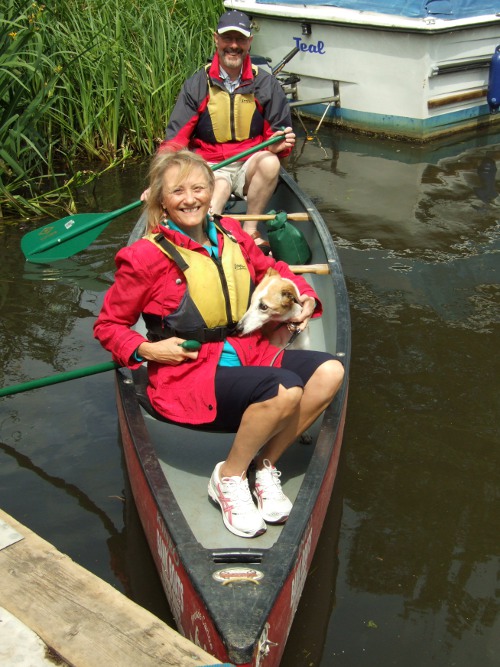
Once in the boat the lady serving us offers to take our photograph. It's the first time in a while that my bare knees have been caught on camera!
We arrived at the boat yard to find an enthusiastic group of lads managed to get served before us but that didn't matter too much. They went off in a set of small kayaks, while we opted for a Canadian canoe. We were encouraged to put valuables, such as car keys and credit cards in the dry bag that they supplied, although it was suggested that I keep my camera at the ready as it was too easy to miss things when struggling to get a camera out of the bag. As it turned out, it was easy to miss things even when the camera was in your hand - but that's herons for you!
 North Walsham & Dilham Canal
North Walsham & Dilham Canal
Emerging from Bank Boat's dyke we turned upstream pausing briefly under Wayford Bridge and then paddled past the house boats just above the bridge. They've been there since at least the early 1960s and these days look a little dowdy and in need of a repaint. The leaflets at the yard suggest that it should only take 20-30 minutes to reach the first land mark on the North Walsham and Dilham Canal so, beyond the houseboats, we turn in that direction.
Initially, there is a long sweeping tree-lined curve that turns almost 90° to the right. Somewhere round the curve there is rickety boat house, leaning for far you feel it must shortly collapse, half buried in the trees on the right. Then you find yourself on a long straight section. Some half a mile ahead we could see the youngsters in the kayaks. We stopped paddling a couple of times so I could take photos. That produced some problems as we didn't seem to drift in a straight line and ended up in the trees. The advice we had been given was always to lean forward or back when needing to duck for trees and never sideways. That was easier said than done!
The encounter with the trees seems to encourage Izzie to believe that the flat stuff just over the side of the boat - she does have a little sight - must be walkable and she began to get restless. Diana became concerned and Diana eventually took Izzie in her arms and placed her in front of her where Izzie settled for the rest of the trip causing no further worry, although perhaps restricting Diana's paddling a bit.

Early in our cruise soon after turning up the North Walsham and Dilham Canal.
 Tonnage Bridge
Tonnage Bridge
Near the end of the straight, we are surprised by a day boat which approaches on tick over and pass us by. The occupants give a cheery wave. On our left the trees began to thin and we found ourselves passing a field of highland cattle. That was something I hadn't expected! There's one particularly impressive animal with a dark coat, that I take to be a bull and a group of lighter brown ones, all lying down, a little way off.
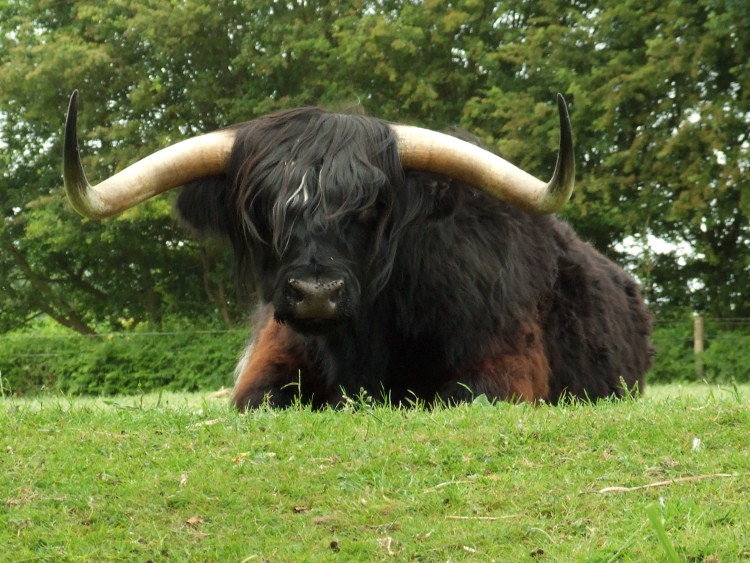
A splendid dark coated beast stares directly at us, apparently totally unconcerned.
As we pass the slight bend round the small field we see what must be Tonnage Bridge. It's a simple brick and flint affair with evidence of much repair over the years. Equally interesting is the impressive oak framed boat house just to its left and the cottage behind. We assume that this is where the day boat came from.

The Approach to Tonnage Bridge reveals a splendid modern boathouse just to its left.
I feel that we ought to pass through the bridge, to be able to say that we had truly "done" it and am surprised to find the the northern side has been completely rebuilt and sports a crest with the date 1981 over it. I've no idea whether it is the crest of the Canal company, but presumably the date is when it was rebuilt.

The modern northern side of Tonnage Bridge. complete with crest and 1981 date.
After taking the photograph at Tonnage Bridge we made our way back down the canal. My hope was that we'd be able to make it up Tyler's Cut to the head of navigation. It had taken us a little longer than the suggested 20-30 minutes to reach the bridge, so it was going to be a close run thing. However the return was uneventful. We quickly left behind the field of sheep that was on the opposie side from the cattle and we were soon back to the junction just upstream of the houseboats.
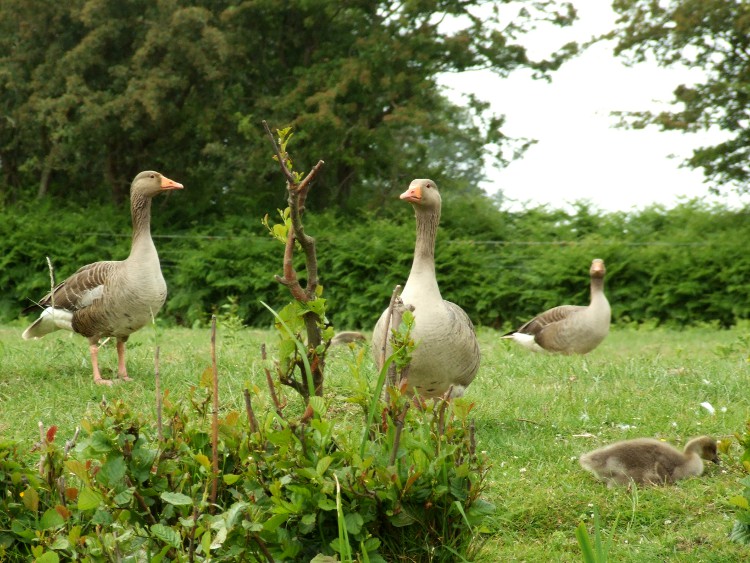
I'd failed to notice the family of Greylag Geese on the way up to the bridge.
 Up Tyler's Cut
Up Tyler's Cut
As we emerged from the canal there was a couple of other canoes making their way up the canal. A woman on one, obviously suffering some nerves herself, said "You look expert!" which was encouraging, but I'm not sure it was true.
I'd always been interested in getting closer to the windmill that you can spot across the field upstream of Wayford Bridge and now I was going to get a chance. I took a photograph as we approached. I remember discovering that there was a much better view a few moments later, but something must have distracted me from taking that picture - probably conversation about the number of damsel flies we were seeing.

Google Maps suggest this fine cottage is rented out as a holiday cottage.
Beyond the cottage the river was much as I remembered it from the days when I used to bring my father's SeaHawk down from the moorings at Dilham. Perhaps the trees lining the river were a little taller and more dense than back in the 1970s, but I can't be sure.
 Approaching Dilham
Approaching Dilham
Further up the cut, in the last four hundred yards before reaching the moorings, I am more certain that the field on the right had no shrubs overhanging the bank. Then, I believe, the bank was entirely open and there was frequently cattle found in the field. Today half the length of the field was lined with assorted shrubs. I might have complained that they blocked the view but, this time, I welcomed them as they helped keep the wind off the river and that made for easier paddling.
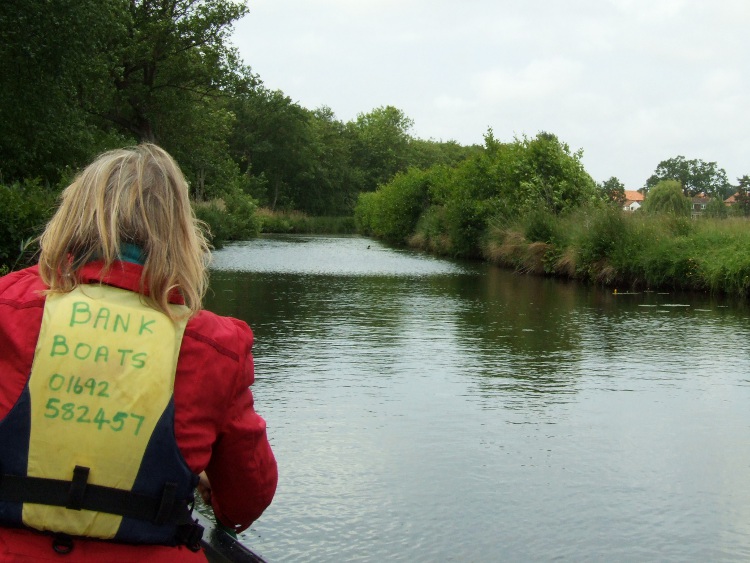
I don't remember the shrubbery on the right bank in final few hundred yards before reaching Dilham.
Around a year ago I took Tony and Annette to visit my father's old Dilham mooring. They were two friends who, in 1976, had sailed with me from it. When visiting with them last year the moorings were certainly a lot more mature than I had recalled. Many of the plots were tidily maintained gardens with boundary hedges and tall trees in them. Beyond the moorings there seemed to be more houses in the few yards up to the head of navigation. In particular, I have no recollection of the massive lines of poplar trees in one of the gardens. It all goes to prove that a lot can change in forty years!
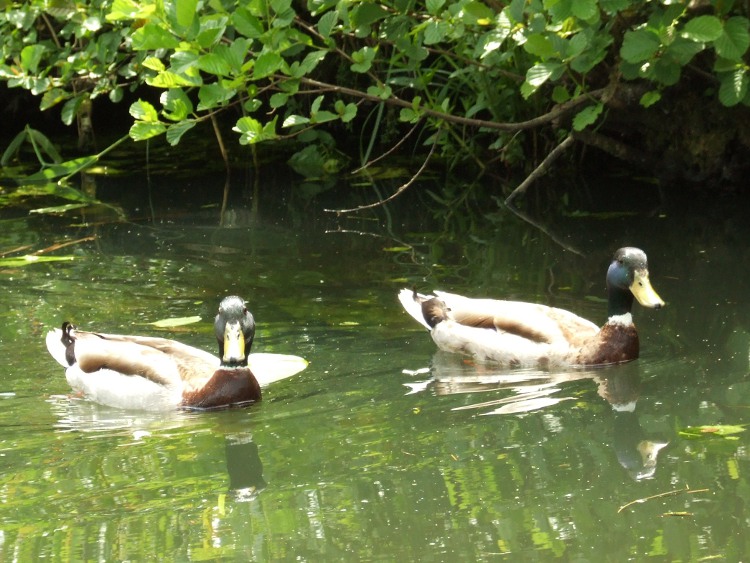
A pair of Mallard took no notice as we paddled past them.
I had wanted to try try to do two things when at Dilham, one was to see Dad's mooring from the water and the other was check out the very head of navigation. I had taken a photograph of Dad's SeaHawk, Jemima, on the mooring at the end of that 1976 cruise with Tony and Annette and I remembered the head of navigation as being a bridge that was little more than a culvert emerging from a brick wall.
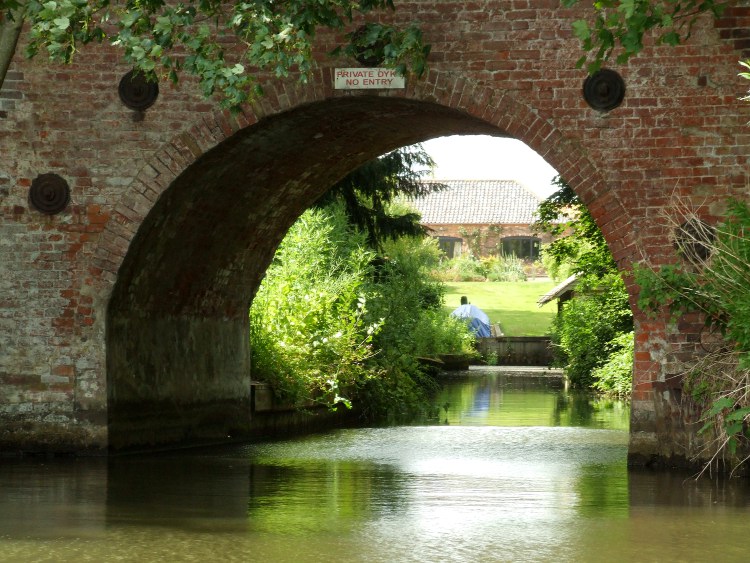
The bridge at the head of navigation on Tyler's cut. It turns out there is quite a reasonable bridge there and not the two foot high culvert I had recalled.
There certainly are more properties in that final couple of hundred yards to the bridge, with a number of modern bungalows almost all with well maintained gardens and a boat, dock or small slipway. At the very end are a few yards of public moorings. They are on a tight curve so long craft might have a struggle to moor neatly, but the couple of "Mr Canoe Man" canoes we saw there, along side a small cruiser fitted fine.
While preparing this entry, took a look at The Canoe Man site and, perhaps, discovered why I've been told that the Broads Authority seem to give that business more prominence on their site. It opens with the words "The Broads National Park" when we all know that the Broads is NOT a national park. To be a National Park you must give precedence to nature conservation. In the Broads Authority's case this conflicts with its statutory navigation duties hence, under current legislation, it can never be a full fledged national park. Many claim that the nature conservation lobby within the Broads Authority is hell bent on ditching its navigation duties, hence the desire to achieve National Park status. These folk believe that businesses that promote the Broads Authority as a National Park get some favours in return.

Daddy Duck comes flying in, lands, does a U-turn while Mummy Duck complains bitterly at the splash! I wish I had caught this shot half a second earlier!
 Return To Wayford
Return To Wayford
We hadn't left ourselves long to get back to Wayford Bridge so we set off at a good steady pace from the end of the cut, missing out on the trip into the moorings that I had hoped we might be able to fit in. Towards the end of the open field, now on the left, we encountered a large hire cruiser proceeding at tick-over and were able to exchange a few words. By the time we met the third equally large cruiser I was telling them that they wouldn't be able to make it to the pub as the moorings would be full.
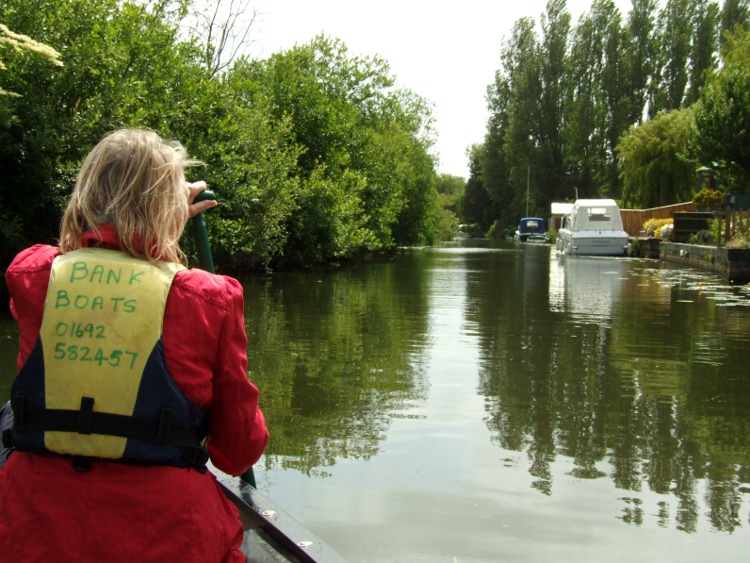
Passing the gardens near the head of Tyler's Cut. I pity the neighbours to the north of the garden with those poplar trees. They must live in perpetual gloom and have all the goodness sucked out of their soil.
The return to Wayford was uneventful. Lots more small blue iridescent damsel flies and, in particular, a heron was spotted. I was so concerned to get a good shot of it that I was distracted from getting a better picture of the cottage with the windmill we had seen on the way up.
After we returned the canoe we both felt it had been an excellent introduction and something we would try again. Diana was pleased that Izzie had settled so well once moved to be in front of her. The only trouble with the trip was that Diana had ended up with blisters on her hands. I teased her that that must have been poor technique as she hadn't added much to add to propulsion. I fancy that didn't go down well so I thought it prudent to concede that it meant she had been working hard and, in truth, with Izzie in front of her, she was never going to be able to achieve the most efficient action.
I wonder if I can persuade Diana that what we really need is a decent sailing canoe. I have always fancied a posh one from Solway Dory, who I met when they came to visit their relations when I lived in East Walton.
